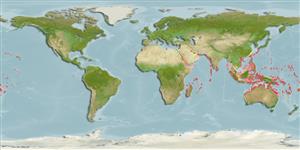>
Acanthuriformes (Surgeonfishes) >
Acanthuridae (Surgeonfishes, tangs, unicornfishes) > Acanthurinae
Etymology: Acanthurus: Greek, akantha = thorn + Greek, oura = tail (Ref. 45335).
Eponymy: Marcus Élieser Bloch (1723–1799) was a German physician and naturalist specialising in ichthyology. [...] (Ref. 128868), visit book page.
More on author: Valenciennes.
Environment: milieu / climate zone / depth range / distribution range
экология
морской ассоциированный с рифами; пределы глубины 2 - 15 m (Ref. 90102). Tropical; 31°N - 34°S, 25°E - 156°W
Indo-Pacific: East Africa, including the Mascarene Islands (Ref. 37792) to the Hawaiian and Society islands, north to Ryukyu Islands, south to Lord Howe Island.
Size / Вес / Возраст
Maturity: Lm ? range ? - ? cm
Max length : 45.0 cm SL самец/пол неопределен; (Ref. 48637); наибольший возраст (опубликованны данные): 35 годы (Ref. 52229)
колючие лучи спинного плавника (общее число) : 9; членистые (мягкие) лучи спинного плавника (общее число) : 25 - 27; колючие лучи анального плавника: 3; членистые (мягкие) лучи анального плавника: 24 - 25. Color in life bluish grey with numerous yellowish brown spots which tend to form irregular longitudinal lines; head with narrow irregular stripes; behind eye a yellow spot; brown pectoral fins; base of caudal fin with white bar. Caudal spine large, 3 - 4.4 in head. Stomach gizzard-like. Differs from A. dussumieri by having vertical stripes instead of spots on the blue central area of the caudal fin, from A. mata by having a lunate caudal fin, and from A. xanthopterus by having plain brown to blue-grey pectoral fins (Ref. 1602). The white ring around the base of the tail varies in intensity and may occasionally be absent (Ref. 1602).
Adults occur in outer lagoon and seaward reefs, usually seen in small groups and school in some oceanic locations (Ref. 48637). Benthopelagic (Ref. 58302). They feed primarily on the algal film covering compacted sand, ingesting the usual component of sand which probably aids in the trituration of the algal food in the thick-walled stomach, also feed on diatoms and detritus (Ref. 3921).
Life cycle and mating behavior
половая зрелость | размножение | нерест | икра | Fecundity | личинки
Randall, J.E., 1987. Three nomenclatorial changes in Indo-Pacific surgeonfishes (Acanthurinae). Pac. Sci. 41(1-4):54-61. (Ref. 1921)
Статус Красного Списка МСОП (Ref. 130435: Version 2024-2)
Угроза для людей
Harmless
Использование человеком
рыболовство: коммерческий; аквариум: коммерческий
дополнительная информация
инструменты
Специальные отчеты
Скачать в формате XML
ресурсы в Интернет
Estimates based on models
Preferred temperature (Ref.
123201): 24.9 - 28.8, mean 27.8 °C (based on 1800 cells).
Phylogenetic diversity index (Ref.
82804): PD
50 = 0.5000 [Uniqueness, from 0.5 = low to 2.0 = high].
Bayesian length-weight: a=0.02089 (0.01363 - 0.03203), b=2.99 (2.87 - 3.11), in cm total length, based on LWR estimates for this species & Genus-body shape (Ref.
93245).
Trophic level (Ref.
69278): 2.0 ±0.00 se; based on food items.
Generation time: 4.4 ( na - na) years. Estimated as median ln(3)/K based on 1
growth studies.
устойчивость к внешним воздействиям (Ref.
120179): низкий, минимальное время удвоения популяции 4.5-14 лет (tmax=35; K=0.25).
Fishing Vulnerability (Ref.
59153): Moderate vulnerability (38 of 100).
Nutrients (Ref.
124155): Calcium = 47.6 [20.1, 143.2] mg/100g; Iron = 0.664 [0.254, 1.601] mg/100g; Protein = 18.2 [16.9, 19.5] %; Omega3 = 0.0856 [, ] g/100g; Selenium = 15.5 [5.3, 43.3] μg/100g; VitaminA = 40.4 [9.0, 161.5] μg/100g; Zinc = 2.73 [0.85, 5.09] mg/100g (wet weight);
